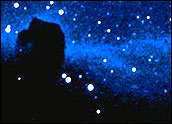
A scientist studying a large, gaseous planet located 150 light-years from Earth has found strong evidence that there is water vapor in the planet’s atmosphere.
Previous analyses of the transiting planet, which resembles Jupiter and is known as “HD209458b,” had not found evidence of water. However, Travis Barman, an astronomer at Lowell Observatory, used new theoretical models and a different approach to studying the planet’s atmosphere.
His study is based on an earlier analysis of visible and infrared data from the Hubble Telescope by Harvard researcher Heather Knutson. The results of his study have been accepted for publication in Astrophysical Journal.
“We now know that water vapor exists in the atmosphere of one extrasolar planet, and there is good reason to believe that other extrasolar planets contain water vapor” as well, Barman said.
A Useful Eclipse
Scientists have expected to find water vapor in the atmospheres of nearly all of the known extrasolar planets, which are those that lie beyond the solar system. However, for most extrasolar planets, their close proximity to their parent star has made detecting water and other compounds difficult.
Barman’s study uses the fact that HD209458b, as seen from Earth, passes directly in front of its star every three and half days, creating a sort of eclipse. When that happens, its atmosphere blocks a different amount of the star’s light at different wavelengths.
Specifically, absorption by water in the planet’s atmosphere makes it appear larger across a specific part of the infrared spectrum compared with wavelengths in the visible spectrum.
“It is encouraging that theoretical predictions of water in extrasolar planets seem to agree reasonably well with observations,” said Barman.
‘Hot Enough to Melt Lead’
“This is something we will definitely be looking at,” Mario Livio, senior astrophysicist at the Space Telescope Science Institute, told TechNewsWorld. “If confirmed, these results are very interesting.”
“The identification of water vapor is extremely important,” agreed William Newman, professor of earth and space sciences at the University of California at Los Angeles.
However, while observers are often tempted to infer the possibility of life wherever water exists, Newman cautioned that that won’t be the case on HD209458b, which is “hot enough to melt lead” and entirely gaseous. “You’re not going to find biology there,” he stated.
What Will the Neighbors Be Like?
However, if smaller, rocky planets are found nearby — planets more like Earth, that is — the presence of water around HD209458b could be promising.
“If you have a smaller, rocky planet and the presence of water in a Jupiter-size neighbor, that could suggest the smaller planet could also harbor water,” Newman told TechNewsWorld. “On smaller, rocky planets, the presence of water goes a long way toward establishing the prerequisites for life — not life, but simply the prerequisites for it,” he said.
Like most research, Barman’s assertion that he has detected water in the atmosphere of HD209458b is not undisputed.
Alternate Explanations
These “results are intriguing,” said David Charbonneau, assistant professor of astronomy at Harvard University, who was a coauthor with Knutson of an earlier analysis of the Hubble data.
This paper “will no doubt help advance the field by forcing a closer comparison between astronomers’ theoretical expectations of these exotic planetary atmospheres with actual data gathered by premier observatories such as the Hubble Space Telescope,” he said.
“However, my concern is that [Barman] may be over-interpreting our data. In our paper, we made it clear that the apparent variations with color that we tabulated could be due to the telescope and instrument, and thus might not be due to molecules in the planetary atmosphere,” Charbonneau added.
In other words, it’s not clear that water is the only possible explanation for Barman’s results; also possible are effects from the telescope used.
An Exciting Prospect
“We think water’s the most likely explanation,” Knutson told TechNewsWorld, but she added that other explanations have not yet been ruled out. “There are more tests we can do,” she said, “especially now that Barman has this very detailed model.”
Nevertheless, if Barman’s results are confirmed, they could lead to similar discoveries on other planets as well.
“It’s exciting because it could be an indication that our models are correct,” Knutson said. “If we can prove this technique allows us to evaluate the atmospheres of other planets, then when we find smaller, rockier ones, it will be a good technique for studying them the same way to see if they have water and are capable of supporting life.”





















































